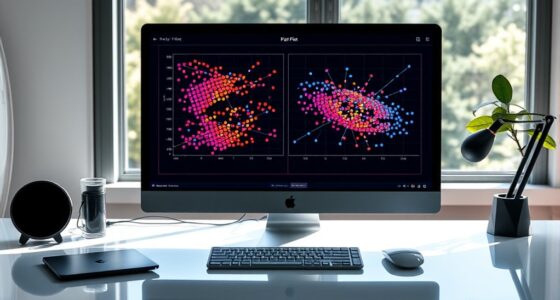AI-powered data storytelling simplifies how you create visual narratives by automatically generating the most relevant charts for your data. It analyzes your information to suggest impactful visualizations, ensuring clarity and engagement. Automation handles technical details, freeing you to focus on crafting a compelling story. With ongoing learning, AI refines its recommendations, helping you communicate insights more effectively. Keep exploring how this innovative approach can transform your data presentations into persuasive stories.
Key Takeaways
- AI automates the selection and generation of appropriate visualizations based on data analysis.
- It suggests optimal chart arrangements to create coherent and impactful data stories.
- AI-driven tools reduce technical barriers, enabling users to focus on storytelling rather than chart creation.
- Automation enhances efficiency, allowing quick iteration and refinement of visual narratives.
- Machine learning improves visualization suggestions over time, aligning with user preferences and storytelling goals.

Have you ever wondered how data can tell a compelling story? It’s a fascinating process, and with AI-powered tools, it’s becoming easier than ever to turn raw data into meaningful insights. At the core of this transformation is data visualization, which allows you to present complex information visually, making it accessible and engaging. Instead of drowning in endless numbers, you can use charts, graphs, and interactive dashboards to highlight key trends and patterns. But creating these visualizations isn’t just about choosing pretty colors; it’s about employing effective narrative techniques to guide your audience through the story your data is telling. AI automates much of this process, intelligently selecting the most appropriate visualization styles based on your data’s nature and context. This means you don’t need to be a data expert to craft compelling stories; the AI handles the technical details behind the scenes, allowing you to focus on the story you want to tell.
By leveraging AI for chart creation, you can guarantee that each visualization aligns with your narrative goals. For example, if your data indicates a rising trend, the AI can automatically generate a line chart that clearly illustrates this, emphasizing the importance of the trend within your overall story. It can also suggest the best way to arrange multiple visualizations to create a logical flow, reinforcing the narrative techniques that keep your audience engaged. These techniques include strategic use of storytelling elements like context, conflict, and resolution, all supported by visual cues. For instance, highlighting anomalies or significant data points can draw attention exactly where you want it, providing clarity and emphasis. AI-driven tools analyze your data and recommend visual storytelling strategies, helping you craft a narrative that’s both compelling and easy to follow.
Additionally, understanding the role of contrast ratio in your visualizations can significantly impact how effectively your story is communicated, ensuring that your visuals are both clear and impactful. Furthermore, automation doesn’t mean sacrificing creativity; it enhances it by freeing you from tedious tasks and letting you experiment with different visualization styles and story arcs. As your data visualization evolves, the AI learns from your choices, refining its suggestions over time to better match your storytelling style. This iterative process ensures your data story remains dynamic and impactful. As a result, you gain a powerful ally in communicating insights—one that not only automates chart creation but also supports your storytelling techniques, making your data-driven narratives more persuasive and memorable. With AI, transforming complex data into engaging stories becomes a seamless, efficient process, helping you engage your audience and drive informed decision-making.
Frequently Asked Questions
How Accurate Are Ai-Generated Data Visualizations?
AI-generated data visualizations can be quite accurate, but their data accuracy and visualization fidelity depend on the quality of input data and algorithms used. You should verify the underlying data and ascertain the AI system is properly trained. While AI tools streamline chart creation, you must review visualizations for potential errors or misrepresentations, maintaining a critical eye to ensure your insights remain trustworthy and precise.
Can AI Customize Storytelling for Different Audiences?
Sure, AI can customize storytelling for different audiences, turning data into tailored tales with clever personalization strategies. It uses audience segmentation to identify preferences, ensuring each group gets a narrative that resonates. So, whether your audience is data-savvy analysts or casual viewers, AI adapts the message, making your insights both engaging and relevant. Just sit back and watch your data tell stories as unique as your audience’s sense of humor.
What Are the Privacy Concerns With AI Data Tools?
You should be aware that privacy concerns with AI data tools revolve around data privacy and ethical considerations. When you use these tools, there’s a risk of exposing sensitive information or mishandling personal data. Guarantee you follow data privacy regulations and prioritize ethical use, like anonymizing data and obtaining proper consent. By doing so, you protect user trust and comply with legal standards, reducing potential risks associated with AI-driven data analysis.
How Do AI Tools Handle Complex or Messy Datasets?
When tackling tricky, tangled datasets, AI tools deftly decode and dissect data by applying meticulous data cleaning and leveraging transparent algorithms. You’ll find that these tools filter out flaws, flag inconsistencies, and foster trust through clarity. By automating these processes, AI enhances accuracy, accelerates insights, and guarantees you grasp complex information confidently, all while maintaining control through visible, understandable algorithms.
What Skills Are Needed to Implement AI Storytelling Solutions?
To implement AI storytelling solutions, you need strong data literacy to interpret and prepare data effectively. You should also have skills in visualization design to craft clear, compelling visual narratives. Familiarity with AI tools and programming languages like Python or R is essential for automation. Additionally, understanding storytelling principles helps you craft engaging insights. Combining these skills enables you to efficiently create automated, impactful data stories that resonate with your audience.
Conclusion
Imagine transforming complex data into mesmerizing stories effortlessly—by 2025, AI-powered tools are expected to automate over 80% of data visualization tasks. This means you can spend less time creating charts and more time uncovering insights that drive decisions. With AI handling the heavy lifting, you’ll see your data come alive in vivid, meaningful ways, making your storytelling more compelling and impactful. Embrace this shift, and watch your data’s story unfold seamlessly.










